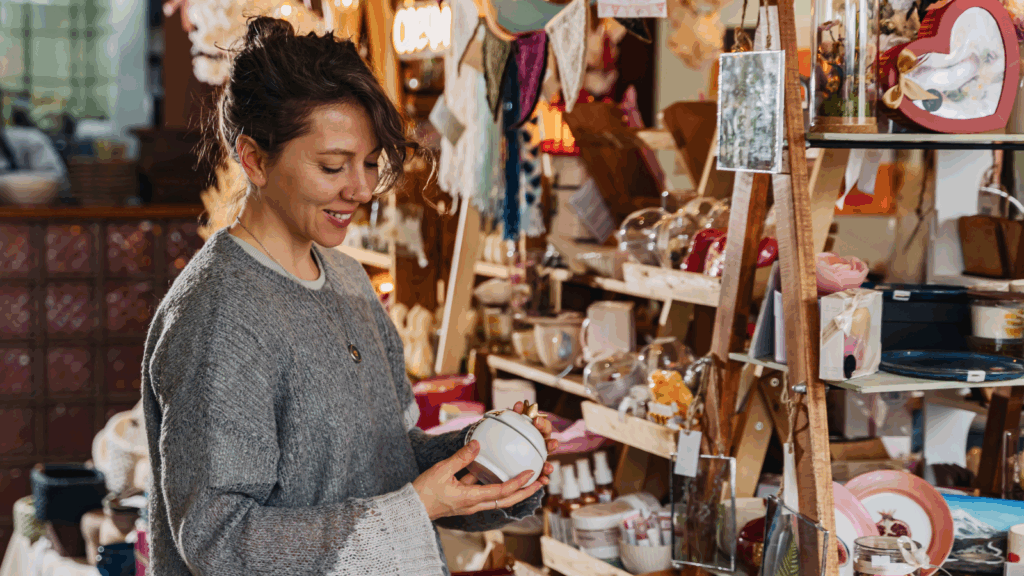Turn passion into profit with Printify
Do you dream of earning from your creations but feel uncertain about how to make money as an artist?
No matter where you are in your artistic journey, this guide explores how to make money selling art, from gallery representation to generating passive income with Print on Demand (POD).
This post may contain affiliate links, which means we may earn a commission if you make a purchase through those links. This comes at no additional cost to you.
Key takeaways
- Diversify your income streams by exploring online and offline opportunities, like selling on marketplaces, creating a blog, or offering art commissions.
- Build a strong digital presence with a website, social media, and platforms like Etsy, while actively engaging with your audience to drive sales.
- Leverage passive income options like print-on-demand services and digital downloads to scale your work and generate consistent revenue.
12 Creative ideas for making money as an artist online and offline
Looking to grow your art business? Here are 12 practical income ideas. While some are more suitable for fine arts, others apply to different creative fields, including music and sculpture, offering something for everyone.
1. Use online art marketplaces

Selling on online art marketplaces is the easiest way for new artists to reach a global audience.
Choose from the following platforms, with an existing audience of art buyers and built-in tools for marketing, payment processing, and shipping.
- Saatchi Art
One of the largest and most reputable online art galleries, Saatchi Art, focuses on physical art and provides excellent exposure for emerging and established artists. Register and create an artist account. - Artsy
A leading online marketplace that connects collectors with galleries, offering a vast marketplace for contemporary and modern art. To sell on Artsy, artists must partner with a gallery. - Etsy
This eCommerce platform is one of the most popular online art marketplaces. Register for an Etsy account to create a shop and sell anything from digital to traditional art forms.
Explore our blog to learn more about how to sell digital art and expand your reach by offering downloads, printables, and NFT merch.
2. Create a website on an eCommerce platform
Selling original artwork online is an excellent option for self-representing artists. eCommerce platforms enable you to build a website with integrated shopping features, serving as your primary sales channel.
To succeed, choose from the online platforms below with strong website building, sales, blogging, SEO (Search Engine Optimization), and content management tools.
- Shopify
As a leading platform, Shopify allows selling art online through customizable stores, supporting physical and digital art sales. Sign up for a free Shopify trial. - Wix
Wix is an excellent option for artists who want to create a visually striking online store and sell physical and digital art pieces. Sign up to create a Wix store and try its easy-to-use website builder.
- Squarespace
Known for its visually appealing templates, Squarespace is an excellent choice for physical and digital creators. Set up an art store on Squarespace with intuitive eCommerce features.
3. Create art prints with POD

Print on Demand helps you scale your art business while generating passive income. Platforms like Printify empower artists to reproduce their original art on canvases or other physical products, such as classic t-shirts and customizable mugs.
As an artist, explore various categories, including print-on-demand consumer products. Use all of these items to showcase your art at events and art shows or sell it online.
No upfront investment, inventory, or storage is needed, as your art prints are only produced and shipped after a customer orders from your online store.
Printify offers integrations with eCommerce and art marketplaces, allowing you to sell directly through the most popular platforms, like Shopify and Etsy.
Once you create your online store, easily connect it with Printify.
- Sign up
Create a free Printify account and click Add a new store to connect Printify.
- Pick items for your art reproduction
Browse through Printify’s Product Catalog to choose the items you’d like to feature your art on.
- Prepare your art for printing
Customize selected items with high-quality images of your art. Upload them to our intuitive Product Creator and check the mock-up of your final print before sending it to production.
- Sell on your store or order for yourself
Once you’ve created the final product, publish it in your online store and start selling prints. You can also order a sample for yourself.
Still wondering how to make money from art? Start with Printify!
4. Turn social media into your sales channel

Next, let’s explore how to make money as an artist on Meta and TikTok. Make sure the eCommerce platforms you choose to build your store support the necessary plugins or extensions for social media sales channels.
- Meta
Create a Facebook page and post content, alternating between sales and informative posts. If you want to reach a younger audience, create an Instagram business account and post high-quality images.
To turn your social media into a sales channel, use Meta’s eCommerce features for Facebook and Instagram business shops. These features let you connect your store and allow followers to browse products and purchase art without leaving the app.
- TikTok
TikTok has the youngest audience among social networks, focusing on entertainment through short videos.
To get started, sign up for a TikTok business account, list your products, and connect your store. Then, set up a TikTok shop, an in-app feature that allows users to buy products directly from your videos.
If you have a print-on-demand store using platforms like Etsy or Shopify, integrate it with your social media to increase sales and expand your audience.
5. Start an art blog
If you have a website or online store with built-in tools for content creation and visibility, consider adding an art blog to showcase your expertise, highlight the creative process, attract buyers, and generate income.
- SEO
Optimizing your blog posts with relevant keywords can increase your site’s ranking in Google results and attract potential customers. Use tools like Google Trends or extend your research on Semrush.
- Selling art
Blogs are excellent for promoting and selling original pieces, art prints, digital downloads, music, or courses. Your blog posts can link directly to products in your online store, creating a seamless connection between content and eCommerce.
- Advertisement and affiliate links
Ad platforms like Google AdSense allow you to display ads tailored to your audience, earning money each time a visitor clicks on or views an ad.
Partner with relevant companies, such as those offering art supplies or creative software, and earn commissions on sales through your affiliate links.
Explore how to monetize a blog and expand your reach.
6. Create a YouTube channel

Grow your following, showcase your art, and monetize your expertise by starting an art YouTube channel.
Share your music creations or even start a podcast on YouTube, which allows you to reach different audiences through various formats.
Combine time-lapse videos, step-by-step tutorials, and in-depth guides to create educational content and monetize your YouTube channel.
- Join the YouTube Partner Program
You’ll need at least 1,000 subscribers and 4,000 watch hours.
- Turn on ads
Once you qualify, turn ads on and earn from views and clicks.
- Use affiliate marketing
Promote products in your videos and earn commissions.
- Sell your art
Include links to your online store, art marketplace, or portfolio in video descriptions.
- Offer memberships
Provide exclusive content to paying subscribers.
Once you’ve expanded your reach and grown your following, consider offering podcast merchandise to your audience.
7. Teach art by creating online courses
Creating an online course is one of the best examples of how to make money as an artist. Teaching art classes online generates revenue, helps refine your skills, and builds a wider audience.
Teach by hosting live video sessions, recording educational videos, and creating written content. Start with what you do best, teach the fundamentals, and develop how-tos to monetize your online art courses.
- Use online course platforms
Leverage platforms like Skillshare or Udemy to host and sell your art course. These platforms handle the technical aspects, allowing you to focus on creating valuable content.
- Offer subscriptions
Provide ongoing lessons through a subscription model, where students pay a recurring fee for access to exclusive content and regular updates.
- Sell exclusive downloadable content
Offer premium downloadable materials of your course content, such as worksheets, templates, or additional project guides.
8. Work as a freelancer
Freelance artists have the flexibility to take on diverse projects, from graphic design to music production, while working independently. With the right strategy, it can become a profitable career path.
- Define your niche
Narrow your focus to a specific type of work and establish yourself as an expert in that area.
- Show your portfolio
A well-designed website or online store showcasing your portfolio is essential for any freelance artist. Highlight your best work, client testimonials, and services offered.
- Leverage social media
Visual artists can use platforms like Dribbble and LinkedIn, while musicians can consider Bandcamp. Social media is crucial for networking, sharing your work, and attracting potential clients.
- List yourself on freelancing platforms
Sign up for platforms like Fiverr to gain visibility and explore opportunities.
Freelancing can offer freedom but requires careful financial planning. Be mindful of your cash flow, tax obligations, and contractors’ rights in your country.
9. Become a streamer

Streaming art is similar to recording courses. Stream online art tutorials, creative processes, or studio tours.
Although YouTube Live is the most popular choice for live streaming, you can also use social media channels and other specialized platforms.
- Behance
Behance is Adobe’s social network that empowers creatives to live stream from Photoshop or Illustrator on iPad or via third-party solutions.
- Picarto
Picarto is a leading live-streaming platform for creators, including artists, musicians, and professionals from the gaming industry.
- Spotify
Spotify is a music and podcast streaming platform where artists can upload their work and earn money based on streams.
- Restream
Restream is a browser-based live streaming tool that allows creators to stream video content to multiple platforms simultaneously without needing external software.
10. Sell at art fairs, festivals, and galleries

Participating in art festivals and exhibiting at local art galleries offers exposure, in-person selling, and networking opportunities with gallery owners and fellow artists.
While participating in an art fair or festival can be costly due to fees and logistics, the benefits extend beyond sales. Networking at these events can open doors for collaborations and future gallery representation.
- Prepare your portfolio
Have a professional portfolio, including business cards, to show to gallery owners or collectors. Invest in display materials that effectively showcase your work.
- Find an art gallery
As most art fairs accept galleries rather than individual artists, consider finding a gallery to represent you and your work. Explore gallery networks like Ocula or Sotheby’s.
- Find the right event
Art fairs often have distinct themes or focuses, so choose the one that matches your style and goals. Select from top international art fairs like Art Basel and The Armory Show.
- Submit applications early
Check the submission guidelines for galleries and apply well in advance. For fairs, apply as soon as the registration opens.
11. Apply for art competitions and grants
Grants and contests cover various art forms worldwide, including visual arts, music, and writing. Institutions offer art grants to students, young or mid-career artists, art educators, and minorities.
Art contests are competitions where artists submit their work to be judged, with the chance to win prizes, gain recognition, or secure exhibition opportunities.
- Grants
Some art grants are available for artists using technology and innovation, while others support artists addressing social issues. Consider applying to programs like the Pollock-Krasner Foundation.
- Art contests
Select the art contest that aligns with your artistic portfolio. Consider participating in contests like the Sony World Photography Awards and the Lumen Prize for Digital Art.
12. Commission artwork
Commissioned artwork involves an artist creating a custom piece based on a client’s request. This traditional income method lets artists directly connect with patrons interested in their specific style or expertise.
- Sign up on online platforms
Register on sites like Artwork Archive or Art Please to offer commission services and connect with potential clients.
- Prepare clear terms
When accepting commissions, create a detailed contract covering price, deadlines, payment terms, rights, and expectations.
- Communicate effectively
Maintain open communication with your clients, ensuring all project details are discussed and agreed upon to avoid misunderstandings.
As commissions can be unreliable, generate passive income by selling high-quality prints of your commissioned work to expand your business.
With Printify, easily reproduce your art on various products. Explore our Product Catalog to print your artwork on postcards and canvases using fine-art quality Giclée printing, or apply it to home decor items.
Tips on how to make a living as an artist

Follow these tips to elevate your presence in the art world, effectively reach a global audience, and monetize your creative work for a thriving career.
Know how to market yourself
Many artists miss out on profits due to limited visibility. Marketing your art should be a top priority if you want to make art your full-time job.
- Follow other artists
Learn from other artists who have found success online. Use their work as inspiration to refine your style by adding your own touch.
- Brand yourself
Pick a name reflecting your brand and work on your public image. Purchase a brandable name with an available domain. Use the same name on your website, social media, and YouTube channel.
- Engage with your audience
Building a strong connection with your audience is key to marketing yourself. Be ready to show your face and voice, respond to comments, host live streams, and share behind the scenes.
Maintain a constant presence on social media
Although social media plays a crucial role in how to make money with art, simply posting pictures won’t automatically generate sales.
- Manage your time wisely
Strike a balance between creating art and networking by tracking the time you dedicate to each, ensuring both skill development and the growth of your online presence.
- Stay true to your artistic vision
Create art that mirrors your passion, not for likes. Use social media to showcase, not shape, your work.
- Offer valuable content
Share more than just images of your art. Provide value with educational content, tutorials, or blog posts that engage and teach your audience.
Build a unique online presence strategy
To develop a strong online presence as an artist, maintain a well-rounded digital profile across multiple platforms, extending beyond just social media.
Expand your online presence to include a professional website, YouTube channel, and platforms like Etsy. Additionally, establish an email list to keep fans updated on new releases and special offers.
Combining these platforms into a multilayered strategy allows you to grow your audience, engage more effectively, and increase your art sales.
Explore more about advanced tips on how to sell art online in our blog.
Invest in equipment
Digital artists should invest in a powerful computer and drawing tablet, while video creators or photographers should focus on good lighting, cameras, and editing software like Adobe. Musicians need quality sound equipment and software like Ableton Live Lite to produce professional audio.
For painters and traditional artists, high-quality art supplies like brushes, paints, and canvases are key, along with proper lighting for an ideal workspace.
Focus on exposure
Use every available resource to showcase your artwork. Without proper exposure, it’s difficult to understand how to make money as an artist or grow your career.
Think outside the box and explore non-traditional spaces like galleries and exhibitions.
Consider displaying your artwork in local businesses, such as cafes or shops, which often support local artists and benefit from enhancing their environments. These unconventional spaces can help you reach new audiences and expand your visibility.
FAQ
To start, build a strong portfolio and create an online presence on platforms like Etsy or Instagram. Diversify income by selling originals or prints or offering commissions.
Yes, artists can earn well by selling originals, prints, or merchandise through commissions or licensing deals. Success relies on consistent marketing and reaching the right audience.
Contemporary art and high-end original paintings from well-known artists often sell for the most money. Abstract, figurative, and digital art (including NFTs) are also popular for generating income.
Only a third of an artist’s income comes from selling their art. Success usually requires artistic talent, networking, and consistent marketing.
Earn money as a professional artist
You now have a solid understanding of how to make money as an artist, both online and offline, by diversifying your income streams and exploring various creative opportunities.
Now it’s your turn to create your own art business. Sell art online or in galleries, and earn passive income with digital art, a personal art blog, or Print on Demand.






















